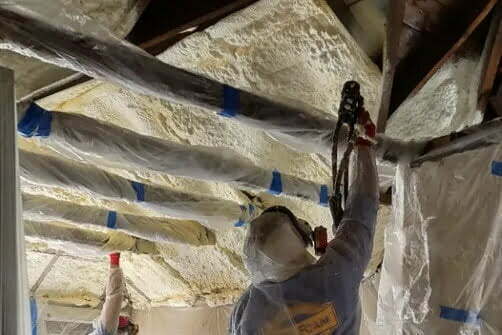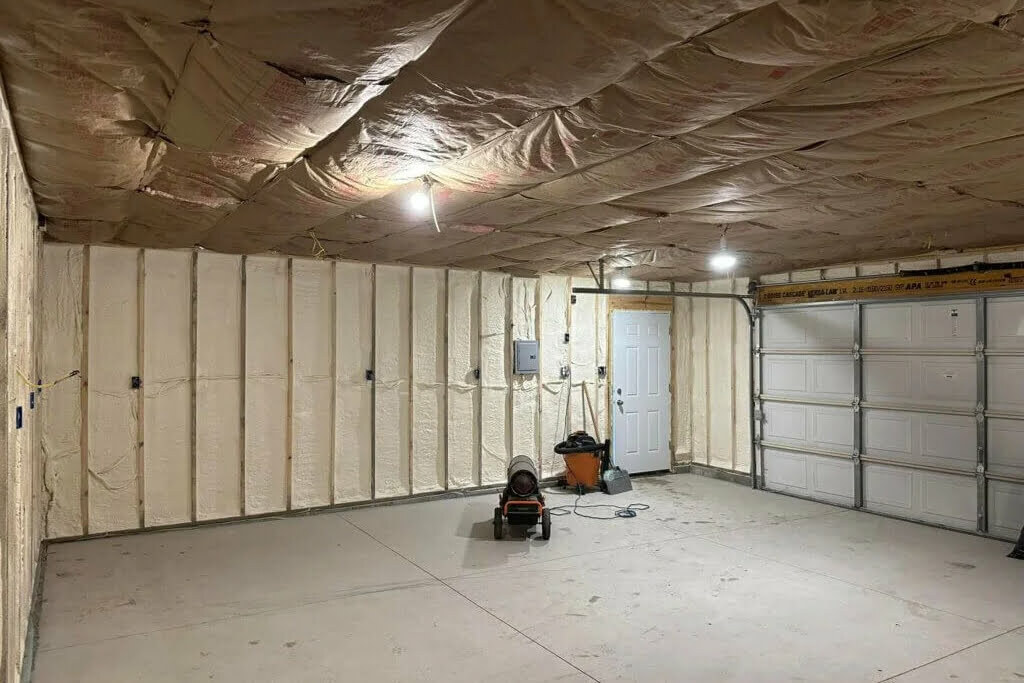When considering the use of spray foam insulation for your home or business, it’s essential to fully understand its composition, curing process, and the potential safety concerns surrounding its application. We’ll dive deep into these aspects, providing you with the information you need to make an informed decision. So, is spray foam insulation safe after it cures? Read on and find out.
Understanding Spray Foam Insulation
Spray foam insulation is a popular insulating material used in both residential and commercial buildings. It provides excellent thermal insulation and air sealing properties compared to more traditional insulation materials like fiberglass batts. Spray foam insulation is created at the job site by mixing two liquid components together that react and expand into foam. The foaming reaction fills cracks and crevices while creating a seamless barrier against heat loss and air infiltration.
What is Spray Foam Insulation?
Spray foam insulation refers to a range of spray-applied plastic foams used to insulate buildings. The two main types are open-cell spray foam and closed-cell spray foam. Open-cell foam has a lower density and is more flexible and breathable. Closed-cell foam has a higher density and acts as a moisture barrier. Both types expand and harden to fill the spaces where they are applied.
The liquid components used to make spray foam insulation include polyol resins and isocyanate constituents. These are kept separate until applied at the job site by a qualified installer using specialized spray foam equipment. The mixture activates a chemical reaction that causes the foam to quickly expand 30 to 60 times its original volume to fill cracks, seams, and spaces.
The Composition of Spray Foam Insulation
Spray polyurethane foam consists of two main liquid components that must be heated and pressurized for proper spray application:
- Polyol resin: acts as the foam resin
- MDI isocyanate: the foaming agent
Polyol resins are typically made from petroleum derivatives like propylene glycol. MDI isocyanates use methylene diphenyl diisocyanate. When heated and pressurized, these components are sprayed simultaneously through the spray gun mixing chamber to create an exothermic chemical reaction resulting in rigid foam.
Other additives may be included in the foam components:
- Catalysts control reaction speed
- Fire retardants improve fire resistance
- Surfactants modify expansion rates
- Fillers reduce costs
The Curing Process of Spray Foam Insulation
Understanding the curing process of spray foam insulation is important for proper installation and safe occupancy of the building space after application. The curing process refers to the chemical reaction that transforms liquid components into solid, finished foam insulation.
How Does Spray Foam Insulation Cure?
When the polyol resin and isocyanate are mixed, they begin an immediate chemical reaction known as polymerization. This causes rapid expansion and chains of molecules begin to bond, increasing in molecular weight and cross-linking density. The components continue to react until they form into a solid plastic foam matrix. The curing process may take several hours to several days to fully complete depending on the product and environmental conditions.
Factors Influencing the Duration of the Curing Process
Several key factors impact how quickly spray foam insulation will cure:
- Temperature: Colder temperatures slow down the reaction.
- Humidity: High humidity can speed up or slow down curing.
- Thickness: Thicker foam sections take longer to cure.
- Foam density: Higher-density foams have more material to cure.
- Ventilation: Good airflow accelerates the curing process.
The particular formulations used in the foam components also influence curing rates. Product manufacturers provide guidelines on cure times specific to each spray foam product.
The Role of Temperature and Humidity in the Curing Process
Temperature and humidity play key roles in spray foam curing:
- Higher temperatures accelerate the chemical reactions so foam cures faster.
- Lower temperatures slow the reaction and extend the cure time.
- Moderate humidity (40-60%) is ideal for curing foam.
- High humidity can absorb heat from the reaction and inhibit curing.
- Low humidity may dry the foam too quickly, preventing complete curing.
Installers must monitor on-site temperature and humidity conditions and follow the product manufacturer’s suggested guidelines for proper spray foam application and curing.
Spray Foam Cure Time
Spray Polyurethane Foam (SPF) is made from two liquid chemical components that must fully react and cure to become solid foam insulation.
How long full curing takes depends on the specific SPF formulation, temperature, humidity, and thickness of the foam insulation layer. Curing can take several hours up to 2 days. Following the product manufacturer’s guidelines ensures full curing and minimizes off-gassing risks.
Factors that Guarantee Safe Spray Foam Insulation Use
Importance of Professional Installation
Trained SPF technicians have extensive safety training and work experience. They follow strict personal protection protocols using respirators, gloves, and protective clothing when working with chemicals.
Professional installers have specialized equipment to monitor temperature and control foam thickness. Their precision application minimizes off-gassing by ensuring proper curing. Rushing the job or applying foam too thickly increases safety risks.
Homeowners looking to DIY should get professional training. Spray foam chemicals and vapors can be dangerous if mishandled. Consider hiring a professional insulating contractor for optimal safety.
Proper Maintenance and Inspections
It’s wise to reinspect spray foam insulation periodically. Check for any cracks, melting, or deterioration which may indicate trapped moisture or underlying issues.
Repair any mechanical damage immediately to prevent hidden off-gassing exposure. Use fans and ventilation when making repairs. Consider sealing damaged areas with a radiant barrier paint to contain chemical release.
Good maintenance also includes keeping the space clean. Dust and debris should not accumulate on the foam over time. Follow the manufacturer’s care guidelines.
Recognizing and Dealing with Improper Curing
Off-gassing odors, visible vapor, discoloration, soft spots, or shrinking foam post-installation may indicate improper curing.
If this occurs, ventilate the space immediately per the manufacturer’s guidelines. Determine the cause of incomplete curing, such as too thick of an application, cold temperatures, or high humidity.
To mitigate risks, the installer may apply a radiant barrier sealant layer over affected areas. Remove and redo severely compromised sections. Report unresolved off-gassing to the SPF product manufacturer.
Trust Cincinnati RetroFoam for Spray Foam Insulation
When it comes to spray foam insulation in Cincinnati homes and buildings, there’s one company you can trust – Cincinnati RetroFoam.
As a local company rooted in Cincinnati, we understand our climate, older housing stock, and the benefits spray foam can offer. We offer top-quality open and closed-cell foam solutions to match your project. This leads to optimal energy efficiency and comfort improvements. From start to finish, you can rely on our team of seasoned professionals to implement spray foam insulation right. We take care of assessing your existing insulation, determining ideal spray points, and installing the foam throughout cavities.
If you’re looking to upgrade your home’s insulation with spray foam, look no further than the experts at Cincinnati RetroFoam. Our tailored solutions, outstanding service, and results you can count on make us the smart choice for foam insulation.
FAQs
Is expanding foam toxic once cured?
While the components that makeup spray foam are toxic in their uncured state, once the foam has fully cured and expanded, it is generally considered non-toxic and safe for use in homes and buildings. During the curing process, the toxic components react and harden into an inert plastic that no longer poses a health hazard.
Is it safe to be in the house after spray foam insulation?
Spray foam insulation is generally considered safe for indoor use once it has fully cured and any fumes have dissipated. Most spray foam products utilize chemicals that can produce irritating fumes during and shortly after application, so it’s recommended to vacate the space while the foam cures. Once installed correctly by a professional and given enough time to set, spray foam does not pose any significant health risks for occupants.
Is spray foam safe once dry?
Spray foam insulation is considered safe for indoor use once it has fully cured and dried. The major safety concerns with spray foam are during the application process when the chemicals are still wet and exposure should be limited. Once cured, spray foam is inert and no longer emits any vapors or off-gases. It forms a solid plastic-like material that seals air gaps and insulates.


